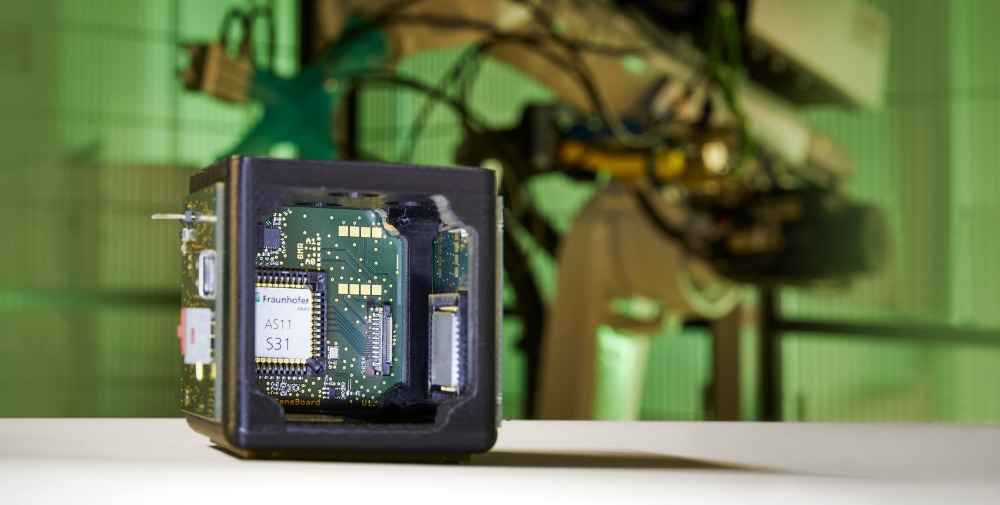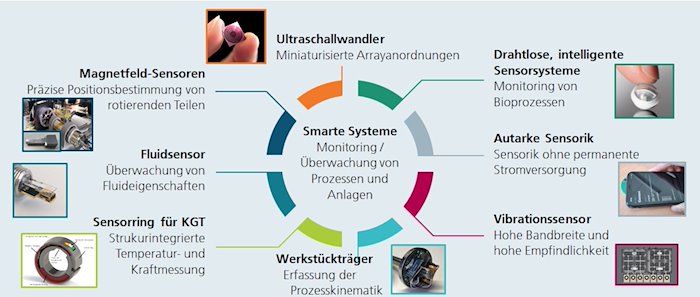Real-time optimisation, predictive maintenance, product quality assurance: smart sensors provide the technological basis – also for new business models.
Categories
Real-time optimisation, predictive maintenance, product quality assurance: smart sensors provide the technological basis – also for new business models.

Categories
Tags
Contact info
Silicon Saxony
Marketing, Kommunikation und Öffentlichkeitsarbeit
Manfred-von-Ardenne-Ring 20 F
Fax: +49 351 8925 889
Contact person:
Miniaturised sensors are an essential component in smart systems. Their development and increasing use is closely linked to the rapid development of microsystems technology. Sensor technology is a key technology.
A sensor is a technical component that can qualitatively or quantitatively measure certain physical or chemical properties and/or the material composition of its environment. These variables are then detected by means of physical, chemical or biological effects and converted into an electrical signal that can be further processed.
Sensors can be classified according to size and manufacturing technology as well as according to application and its designated usage. In addition, sensors are divided into passive and active sensors.
The term sensor has evolved in recent years. Nowadays, according to AMA [1], sensors are understood to be a system that converts physical quantities and its variations into suitable signals, see Fig. 1. Various functions are already integrated at sensor level.
Fig. 1: Functional blocks of a sensor
The sensor measures the actual value. The sensor component is also characterised by the physical conversion principle. The primary electronics converts the intermediate variables into a fail-save and adjusted analogue electrical output signal, e.g. voltage or current. In the secondary electronics, the conversion into a digital signal and, if necessary, digital signal processing is done. Important topics here are advanced digital signal processing, e.g. error correction, filtering, self-adaptation, self-monitoring.
Before you select a special sensor you have to answer the following questions:
Typical sensor requirements are industry-sector-specific. They go beyond precision, price, design, etc. In process automation, for example, there are very high requirements in terms of measurement reliability, real-time capability, sensor self-monitoring and reliability. Standardised interfaces are also an essential point.
There are many sensor manufacturers in Germany and Europe.
Today, Germany plays a leading role worldwide in industrial sensor and actuator technology based on novel technologies. In addition to a few global corporations, the market is preferably characterised by medium-sized and small companies. With regard to miniaturised sensors, especially the following companies should be mentioned:

Fig. 2: Industry 4.0, Picture © Anna Salari, designed by freepik
The current trend in industry leads to ongoing automation and a connected production, see Fig. 2. The focus here is on making production more flexible, cost and resource efficient, but also increasing productivity while simultaneously increasing quality. To realise this, precise knowledge of the actual process status and thus the measurement and determination of relevant process parameters is crucial. Especially with older machines and systems, this requires the subsequent integration of sensors. This is often referred to as retrofitting older systems.
The continuous collection of data and monitoring of machines and plants leads to a significant reduction in unplanned downtimes. When retrofitting, wireless connected sensors are distributed over several machines and plants. This allows continuous collection of relevant data. The processed data allow then finding very quickly anomalies, wear or other unwanted events of these machines.
A wide variety of sensors of different designs are used, see Fig. 3.
Fig. 3: Sensors for use in production plants

Fig. 4: Prototypical integration of sensors in a ball screw drive
It is often challenging to achieve a process-controlled condition monitoring at hardly accessible positions inside the machines and constructions. Therefore, miniaturized, networked and energy-efficient information and communication technologies (ICT) have to be integrated into machine tool parts.
A joint research team from the High Performance Center »Functional Integration in Micro- and Nanoelectronics« and Fraunhofer IWU works together on the conception, engineering and test of structure-integrated sensor and actuator systems in machine parts. Here, exemplarily shown for a ball screw drive, a structure-integrated wireless sensor technology is implemented into a manufacturing system for advanced process control and status monitoring, Fig. 4.
Several sensor systems can be merged via software and processed via local software. Thereby, data is connected via standard interfaces such as SPI or I³C. Sensor fusion makes it possible to get additional information based the sensor signals locally and without latency.
Bosch Sensortec’s BSX sensor fusion software is a complete 9-axis fusion solution that combines the measurements of a 3-axis gyroscope, a 3-axis geomagnetic sensor and a 3-axis accelerometer to provide a robust absolute orientation vector. The sensor fusion software BSX provides orientation information in the form of quaternions or Euler angles.
The algorithm fuses the raw sensor data from the 3-axis accelerometer, 3-axis geomagnetic sensor and 3-axis gyroscope in a smart way to improve the performance of each sensor. This includes algorithms for offset calibration of each sensor, calibration status monitoring and Kalman filter fusion to provide distortion-free and refined orientation vectors. As the Bosch Sensortec 9-axis fusion software is developed together with the sensor hardware, optimal performance in terms of dynamic range and insensitivity to distortion effects is achieved.
Direct access to the Bosch sensor hardware allows the user to set application-specific operating modes in terms of data rates and noise thresholds. The solution provides a ready-to-use, advanced 9-axis sensor fusion system that reduces complexity for the customer and supports the rapid development of advanced sensor applications.
Cognitive systems are increasingly being used in the industrial environment. This is characterised by the following features [1]:
At the same time, the aim is to further increase the functionality of the sensor technology. Increasingly, MEMS sensors are being integrated. Companies and research institutions are focusing in particular on:
An essential key to sustainably maintaining the German and Europe’s industry’s competitiveness is the ability to use the digital transformation to develop new business models. With the help of specific approaches, not only turnover and market position can be improved, but also the entrepreneurial risk can be reduced.
_ _ _ _ _
[1] Roland Werthschützky: Sensor Technologien 2022; AMA Verband für Sensorik und Meßtechnik e.V.
_ _ _ _ _

Dr. Martina Vogel
Head of the Smart Systems & IoT Working Group, Fraunhofer ENAS

Dr. Alexander Weiß
Head of Business Unit “Intelligent Sensor and Actuator Systems”
E-Mail: alexander.weiss@enas.fraunhofer.de
_ _ _ _ _
The particular strength of the Fraunhofer Institute for Electronic Nano Systems ENAS lies in the development of smart integrated systems for different applications. Fraunhofer ENAS develops single components, technologies for their manufacturing as well as system concepts and system integration technologies and transfers them into production. The institute offers research and development services from the idea, via design and technology development or realization based on established technologies up to tested prototypes.
Fraunhofer-Institut für Elektronische Nanosysteme ENAS
Technologie-Campus 3
09126 Chemnitz
Telefon: +49 371 45001-0